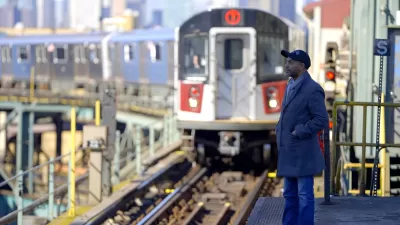Taking cues from the Trump Administration's recently-released infrastructure plan, the government intends to use a public-private partnership model to take on social challenges.

The Trump Administration's infrastructure plan relies, controversially, on states and localities to foot much of the bill for repairs and improvements. As Kriston Capps reports, the government's social impact program embraces a similar model.
Often touted by the Trump Administration, public-private partnerships serve as the basis for these social impact partnerships. Capps writes, "The new law imagines federally fueled, locally driven, public-private partnerships that cut costs for the government. The social goals are practical, from reducing the number of kids in foster care to reducing the number of low-income families receiving means-tested benefits." A new Federal Interagency Council on Social Impact Partnerships will be the gatekeeper here.
"In a typical P3, private investors may finance, build, operate, and maintain an infrastructure project, like a building or a bridge. Social impact bonds instead put that private capital toward a social program, with the government paying returns if certain outcomes are met."
These methods aren't entirely rooted in Trump-era policy. Similar bipartisan proposals have come up, including from the Obama administration. "The result could be a new market for best practices in local government—although it may mean more private companies and faith-based organizations getting involved in basic social services."
FULL STORY: A Brief Guide to 'Social Impact Partnerships'

Trump Administration Could Effectively End Housing Voucher Program
Federal officials are eyeing major cuts to the Section 8 program that helps millions of low-income households pay rent.

Planetizen Federal Action Tracker
A weekly monitor of how Trump’s orders and actions are impacting planners and planning in America.

Ken Jennings Launches Transit Web Series
The Jeopardy champ wants you to ride public transit.

How Project Connect Would Change ‘The Drag’
A popular — and sometimes deadly — Austin road will exchange car lanes for light rail.

Milwaukee Road to Get Complete Streets Upgrades
The city will reduce vehicle lanes and build a protected multi-use trail including bioswales and other water retention features on its ‘secret highway.’

Tackling Soil Contamination With Nature-Based Solutions
Los Angeles County residents and experts are turning to nature-based methods like bioremediation to address long-standing and fire-exacerbated soil contamination without resorting to costly and disruptive removal.
Urban Design for Planners 1: Software Tools
This six-course series explores essential urban design concepts using open source software and equips planners with the tools they need to participate fully in the urban design process.
Planning for Universal Design
Learn the tools for implementing Universal Design in planning regulations.
Ada County Highway District
Clanton & Associates, Inc.
Jessamine County Fiscal Court
Institute for Housing and Urban Development Studies (IHS)
City of Grandview
Harvard GSD Executive Education
Toledo-Lucas County Plan Commissions
Salt Lake City
NYU Wagner Graduate School of Public Service





























